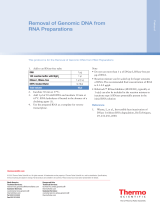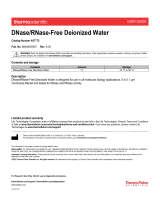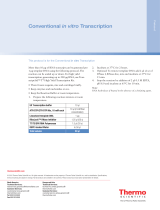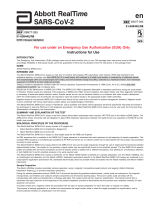Page is loading ...

For Research Use Only. Not for use in diagnostic procedures.
RNA Quantification Kit
USER GUIDE
Catalog Number 902905
Publication Number MAN0017673
Revision A.0

Manufacturer: Thermo Fisher Scientific Baltics UAB | V.A. Graiciuno 8, LT-02241 | Vilnius, Lithuania
The information in this guide is subject to change without notice.
DISCLAIMER: TO THE EXTENT ALLOWED BY LAW, LIFE TECHNOLOGIES AND/OR ITS AFFILIATE(S) WILL NOT BE LIABLE FOR SPECIAL, INCIDENTAL,
INDIRECT, PUNITIVE, MULTIPLE, OR CONSEQUENTIAL DAMAGES IN CONNECTION WITH OR ARISING FROM THIS DOCUMENT, INCLUDING YOUR
USE OF IT.
Revision history: Pub. No. MAN0017673
Revision Date Description
A.0 13 March 2018 Initial release in Thermo Fisher Scientific document control system.
Supersedes legacy Affymetrix™ publication number 703388.
Updated manufacturer.
Important Licensing Information: These products may be covered by one or more Limited Use Label Licenses. By use of these products, you accept
the terms and conditions of all applicable Limited Use Label Licenses.
TRADEMARKS: All trademarks are the property of Thermo Fisher Scientific and its subsidiaries unless otherwise specified.
©2018 Thermo Fisher Scientific Inc. All rights reserved.

Contents
■CHAPTER 1 Introduction ................................................ 4
Product information ............................................................. 4
Kit contents and storage ......................................................... 5
Required materials not supplied .................................................. 5
■CHAPTER 2 RNA Quantification Kit ..................................... 6
Procedural notes ................................................................ 6
Sample preparation ......................................................... 6
Equipment preparation ...................................................... 7
Reagent preparation and kit component handling guidelines ..................... 7
RNase contamination prevention .............................................. 7
Prepare RNA sample ............................................................ 7
Set up real-time PCR ............................................................ 9
■CHAPTER 3 Data analysis .............................................. 11
■APPENDIX A Troubleshooting ......................................... 13
■APPENDIX B Safety ..................................................... 14
Chemical safety ................................................................ 15
Biological hazard safety ......................................................... 16
■Documentation and support ............................................. 17
Customer and technical support ................................................. 17
Limited product warranty ....................................................... 17
RNA Quantification Kit User Guide
3

Introduction
Product information
Target preparation assay kits, such as the GeneChip™ Pico and WT Pico Kits, allow
expression proling using as lile as 100 pg of total RNA (equivalent to
approximately 10 cells). These low amounts of RNA require you to accurately
measure the quantity of input sample RNA that is used in the target preparation assay
for optimal performance. However, at these low RNA concentrations it becomes
dicult to accurately quantify the RNA with standard UV absorbance or uorescent
dye-based techniques.
The RNA Quantication Kit uses Power SYBR™ Green RNA-to-CT™ 1-Step Kit to
measure levels of the consistently expressed 18S ribosomal RNA in human, mouse,
and rat samples. The amount of 18S ribosomal RNA target in the unknown samples is
then scaled against a Control HeLa Total RNA standard curve for accurate
quantication that fails using conventional techniques. The concentration of any
unknown sample can be interpolated from the standard curve that is based on the
quantication cycle (Cq) of the sample. This protocol recommends running at least
two replicate reactions per sample. Test for DNA contamination by including a no RT
added control reaction.
Power SYBR™ Green RNA-to-CT™ 1-Step Kit is a ready-to-use master mix for real-time,
quantitative analysis of RNA templates in a single reaction format. The kit contains
two tubes: Power SYBR™ Green RT-PCR Mix (2X) and RT Enzyme Mix (125X). The
125X RT Enzyme Mix is a blend of reverse transcriptase and RNase Inhibitor. The
Power SYBR™ Green RT-PCR Mix (2X) contains chemically-modied AmpliTaq Gold™
DNA Polymerase, ultrapure nucleotides, SYBR™ Green, and ROX™ passive reference
dye in an optimized buer formulation for quantitative, real-time reverse
transcription PCR detection (RT-qPCR). One kit is sucient for running 1 plate of 6
point standards and 21 unknown samples or 2 plates of 6 point standards and 9
unknown samples per plate in duplicate reactions.
In addition to thePower SYBR™ Green RNA-to-CT™ 1-Step Kit, the RNA Quantication
Kit also includes Control HeLa Total RNA for standard curve preparation and an 18S
rRNA Primer Mix, providing an assay range of 0.002–200 pg/μL total RNA.
1
4
RNA Quantification Kit User Guide

Kit contents and storage
Table 1 RNA Quantification Kit (Cat. No. 902905)
Contents Amount (100-reaction kit) Storage [1]
Power
SYBR™ Green RT-PCR Mix (2X) 1 mL
–20°C
RT Enzyme Mix (125X) 20 μL
10X 18S rRNA Primer Mix (78 nt) 220 μL
Control HeLa Total RNA (100 ng/μL) 5 μL
[1] Refer to label for expiration date.
Required materials not supplied
Unless otherwise indicated, all materials are available through thermosher.com.
MLS: Fisher Scientic (sherscientic.com) or other major laboratory supplier.
Item Source
Microcentrifuge MLS
Pipette MLS
Real-Time PCR instrument MLS
Spectrophotometer and fluorometer
• NanoDrop™ UV-Vis Spectrophotometer
• Optional: NanoDrop™ Fluorospectrometer
• Optional: Qubit™ 2.0 Fluorometer
Thermo Fisher Scientific
Vortex Mixer MLS
Nuclease-free aerosol-barrier tips MLS
Nuclease-free 1.5 and 0.2 mL tubes or plates MLS
Real-Time PCR consumables (plates, stripes and
respective sealing options) MLS
Nuclease-free water MLS
Chapter 1 Introduction
Kit contents and storage
1
RNA Quantification Kit User Guide
5

RNA Quantification Kit
Procedural notes
Purify total RNA
RNA samples must be free of genomic DNA and we recommend including a DNase
treatment with the RNA purication method. The contaminating genomic DNA could
cause over-estimation of the RNA amount. We strongly recommend against the use of
nucleic acid-based carriers during RNA purication because many have been shown
to produce cDNA product in rst-strand synthesis reaction. Select a purication
method or commercially available kit that it is appropriate for your sample type and
amount.
RNA quantification
UV absorbance measurement is the most common and convenient method for
determining ng/μL RNA quantity. Absorbance at 260 nm is used to measure the
amount of nucleic acid present in the sample and concentration can be calculated
using the 260-nm reading and a conversion factor based on the extinction coecient
for each nucleic acid (A260 of 1.0 = 40 μg/mL for RNA). In addition, the absorbance at
230 nm and 280 nm can be used to determine the number of other contaminants that
can interfere with an accurate A260 nm reading and subsequent enzymatic reactions.
However, UV absorbance readings are not accurate when used to quantify low
concentration samples. For example, the lower detection limit for the NanoDrop™
spectrophotometer is 2 ng/μL.
Fluorescent dye-based quantication oers an alternative to UV absorbance for
determining pg/μL RNA quantity. In this method, a nucleic acid sample along with a
series of standards of known concentrations are incubated with a uorescent dye that
bind to dsDNA, ssDNA, or RNA, resulting in increased uorescence at a wavelength
specic to the dye being used. However, one disadvantage to using uorescent dye-
based methods is the absence of specicity with the caveat that some uorescence
dyes oer higher template specicity than others. Therefore, the presence of DNA in
an RNA sample can result in an over-estimation of nucleic acid concentration. Specic
detection of RNA can be achieved using an RNA-specic dye (for example, Qubit™
RNA HS Assay Kit and Qubit™ 2.0 Fluorometer), but the quantication lower
detection limit is 250 pg/μL.
Lastly, measurement of RNA concentrations by a Bioanalyzer can be less accurate,
especially at RNA concentrations less than 25 ng/μL. The RNA 6000 Nano Kit can be
used for RNA quantication of high concentration samples (25 to 500 ng/μL) but the
RNA 6000 Pico Kit must not be used for quantication of low concentration samples.
2
Sample
preparation
6
RNA Quantification Kit User Guide

Program the Real-Time PCR thermal cycler.
• 1 cycle of:
–50°C for 10 minutes
– 95°C for 10 minutes
• 35 cycles of:
– 95°C for 15 seconds
– 60°C for 60 seconds. Acquire real-time uorescence data during this step.
• Properly chill essential equipment such as cooling blocks and reagent coolers
before use.
• Enzymes and Reagents: Mix by gently vortexing the tube followed by a brief
centrifuge to collect contents of the tube and then keep on ice.
• Prepare master mixes for each step of the procedure to save time, improve
reproducibility, and minimize pipeing errors.
• Avoid pipeing solutions less than 2 μL in volume to maintain accuracy and
precision.
• Return the components to the recommended storage temperature immediately
after use.
• Ensure that all temperature transitions to incubation temperatures are rapid
and/or well-controlled to help maintain consistency across samples.
RNase contamination in reagents and the work environment results in failure to
generate amplied targets. Follow these guidelines to minimize contamination:
• Wear disposable gloves and change them frequently.
• Clean and decontaminate work areas and instruments, including pipees, with
commercially available decontamination reagents.
• Avoid touching surfaces or materials that could introduce RNase.
• Use RNase-free lter tips and microcentrifuge tubes.
• Use a work area that is designated for RNA work.
Prepare RNA sample
The Control RNA (100 ng/μL HeLa total RNA) is used as the standard in the RNA
Quantication Assay by RT-qPCR for determining the concentration of total RNA.
Ensure thorough coverage of your quantication range by preparing dilutions to
cover the expected range of RNA concentrations in your samples. We recommend
preparing 6-point 10-fold serial standard curve between 0.01 pg–1 ng per reaction,
which corresponds to 0.002–200 pg/μL.
1. On ice, serially dilute stock Control HeLa Total RNA with nuclease-free water.
Avoid pipeing solutions less than 2 μL in volume to maintain accuracy and
precision. Use the following tables as a guide for the dilutions. Five microliters of
the diluted RNA are needed for each replicate reaction.
Equipment
preparation
Reagent
preparation and
kit component
handling
guidelines
RNase
contamination
prevention
Chapter 2 RNA Quantification Kit
Prepare RNA sample
2
RNA Quantification Kit User Guide
7

Note:
·Up to 5 μL of RNA sample can be added to a reaction. If RNA sample is less
than 5 μL, add nuclease-free water to make up the dierence.
·Avoid pipeing solutions less than 2 μL in volume to maintain accuracy and
precision.
Table 2 Example of control HeLa total RNA dilution preparation.
Stock concentration Volume of RNA
sample
Volume of
nuclease-free
water
Final concentration
HeLa total RNA per
PCR reaction
(5 μL, pg/rxn)
On the day of the experiment, thaw 100 ng/μL stock tube and perform dilutions.
Pre-dilution: 100 ng/μL 2 μL 98 μL 2,000 pg/μL
Standard 1: 2 ng/μL 4 μL 36 μL 200 pg/μL 1,000 pg
Standard 2: 200 pg/μL 4 μL 36 μL 20 pg/μL 100 pg
Standard 3: 20 pg/μL 4 μL 36 μL 2 pg/μL 10 pg
Standard 4: 2 pg/μL 4 μL 36 μL 0.2 pg/μL 1 pg
Standard 5: 0.2 pg/μL 4 μL 36 μL 0.02 pg/μL 0.1 pg
Standard 6: 0.02 pg/μL 4 μL 36 μL 0.002 pg/μL 0.01 pg
Figure 1 Serial dilution.
2. On ice, transfer 5 μL of each diluted Control HeLa Total RNA sample, at least in
duplicate, to each real-time PCR tube or well.
3. On ice, transfer up to 5 μL of each unknown sample, at least in duplicate, to each
real-time PCR tube or well. Bring volume up to 5 μL with nuclease-free water if
less than 5 μL of sample is used in a reaction.
Note:
·RNA samples must be kept frozen and thawed immediately before use.
·Always prepare fresh-dilution of Control HeLa Total RNA.
·Use nuclease-free tubes and nuclease-free water to prepare all the dilutions
including unknown samples (not included).
·After each step, mix the Control HeLa Total RNA dilutions thoroughly by
gently vortexing followed by a fast centrifuge to collect contents of the tube.
Chapter 2 RNA Quantification Kit
Prepare RNA sample
2
8
RNA Quantification Kit User Guide

Set up real-time PCR
IMPORTANT!
·Run all test samples and Control HeLa total RNA on the same plate. This practice
allows the calculation of quantication cycle dierences for each sample relative to
Control HeLa total RNA
·For genomic DNA detection, run all test samples without adding RT Enzyme Mix
on the same plate. This is a no RT negative control that allows for the detection of
genomic DNA contamination for each sample.
·For best results, we recommend at least two technical replicates per sample. It is
highly recommended to prepare a master mix of Power SYBR™ components, primer
mix, and nuclease-free water.
·It is highly recommended to make a master mix for at least ten reactions to reduce
pipeing errors.
·We recommend using 20 μL reaction volumes because accurate and reproducible
setup of 10 μL reaction in 96-well plates using multi-channel pipees can be
challenging.
1. Thaw thePower SYBR™ Green RT-PCR Mix (2X) at room temperature. Keep RT
Enzyme Mix and RNA samples on ice. Mix thoroughly, briey centrifuge to
collect tube contents and then place on ice.
2. Assemble all reaction tubes or plates on ice.
3. The following table is the suggested protocol when nine RNA samples plus the
six diluted Control HeLa Total RNA are run side-by-side.
Table 3 PCR reaction master mix preparation.
Component Volume for 1-well
replicate
Volume for 2 replicates of
6 standards and
9 samples[1]
Volume for 2 replicates of
9 samples no RT
control[1]
Power
SYBR™ Green RT-PCR Mix
(2X))
10 μL 330 μL 198 μL
Enzyme Mix (125X)[2] 0.2 μL 6.6 μL 0 μL
10X 18S rRNA Primer Mix (78 nt) 2 μL 66 μL 39.6 μL
Nuclease-free water 2.8 μL 92.4 μL 59.4 μL
Total volume 15 μL 495 μL 297 μL
[1] With 10% overage to account for pipetting inaccuracies.
[2] Replace with water for no RT negative control.
4. Gently vortex the master mix for a few seconds, quick spin, then return the tube
to ice.
5. On ice, add 15 μL of the PCR Reaction Master Mix to each (5 μL) real-time PCR
tube or well containing the diluted RNA sample for a nal reaction volume of
20 μL.
Note: The PCR Reaction Master Mix maybe added before adding the diluted
RNA samples.
Chapter 2 RNA Quantification Kit
Set up real-time PCR
2
RNA Quantification Kit User Guide
9

6. Cap tubes or seal plates with optically transparent caps or lm.
7. Mix tubes or plates by gentle vortexing, then spin to collect contents without
bubbles (for example, 2–5 minutes at 1,000–2,000 × g).
The following table shows recommended cycling conditions:
Table 4 Real-time thermal cycler protocols.
Standard cycling protocols
1 cycle of:
50°C for 10 minutes:
Reverse transcription of RNA by reverse transcriptase to generate cDNA
1 cycle of:
95°C for 10 minutes:
AmpliTaq Gold™ DNA Polymerase activation and reverse transcriptase inactivation
35 cycles of:
95°C for 15 seconds
60°C for 60 seconds: Acquire real-time fluorescence data during this step
Melt-Curve Analysis:
Recommended to distinguish specific products from nonspecific ones. Consult the
thermal cycler manual for details.
Chapter 2 RNA Quantification Kit
Set up real-time PCR
2
10
RNA Quantification Kit User Guide

Data analysis
To calculate quantication data from RT-qPCR amplication curves, the results must
be ploed as a linear regression of the quantication cycle (Cq) values versus the log
of the RNA quantities to generate a standard curve (Table 5, Figure 2). The slope of
the line is a measure of the eciency of the assay (Figure 2). Slopes between –3.1 and
–3.9 are considered acceptable (110% and 80% ecient, respectively), although a slope
of –3.32 is indicative of 100% eciency. The R2 is a measure of the performance of the
assay, and is the coecient of correlation between the data that are generated and the
results that are expected under ideal conditions (Figure 2). The R2 should be higher
than 0.95, which means that >95% of the total variation in the input samples that make
up the standard curve can be explained by the relationship between the Cqs that is
obtained and their respective concentrations.
The following equation is used to determine quantication data from Cq value of
unknown sample:
Quantity = 10(Cq − y-intercept) / Slope
Calculate the concentration of unknown samples based on the standard curve and
resulting linear equation. The nal concentrations (for example, picograms/microliter)
of the unknown samples are based on the calculated quantity that is derived from the
linear equation, the sample volume that is used per reaction, and any dilution that has
been made.
Genomic DNA contamination of each sample is evaluated by calculating
quantication cycle dierences in the presence and absence of reverse transcriptase
(∆Cq DNA = Cq (without RT) - Cq (with RT)). If a No RT Control sample has a Cq
value 10 cycles higher than an RT Test sample, then the No RT Control sample
contained approximately 1,000-fold less target sequence. Because the target template
in the No RT Control would be genomic DNA, the conclusion would be that 0.1% of
the amplication in the RT Test sample comes from the genomic DNA in the sample,
which is negligible compared to the amplication of the RNA-derived cDNA target
sequence. If the amount of genomic DNA in RNA samples is unacceptably high,
3
RNA Quantification Kit User Guide
11

repeat the RNA purication using a new purication method or perform a DNase
treatment.
Figure 2 Example of control HeLa total RNA standard curve.
Table 5 Log values of the quantities of diluted HeLa total RNA samples.
Tube HeLa Total RNA dilution
final concentration
HeLa Total RNA per
PCR reaction
(pg/rxn)
Log10 HeLa Total RNA per
PCR reaction
(pg/rxn)
1 200 pg/μL 1,000 3.0
2 20 pg/μL 100 2.0
3 2 pg/μL 10 1.0
4 0.2 pg/μL 1 0.0
5 0.02 pg/μL 0.1 –1.0
6 0.002 pg/μL 0.01 –2.0
A Microsoft™ Excel™ template for concentration calculation can be downloaded from
our website.
Chapter 3 Data analysis
Set up real-time PCR
3
12
RNA Quantification Kit User Guide

Troubleshooting
Observation Possible cause Recommended action
Efficiency not in specified range
(80–110%)
For high efficiency (or slope is
higher than –3.1), the problem
is likely related to template.
High efficiency could be due to too much cDNA
in the reaction, which can cause inhibition at
the higher end of the dilution series. Use less
starting template starting at the highest
dilution point.
For low efficiency (or slope is
lower than –3.9), the problem is
likely related to reaction mix.
Your samples can contain PCR inhibitors—
Repurify RNA with a new RNA purification kit,
check A260/A280 reading (should be near to 2.0),
and/or dilute your template and retest again.
Your PCR primer and/or probe design might
not be optimal—optimize your primer/probe
design.
Inaccurate sample and reagent pipetting—
ensure that pipettes are calibrated and
working properly.
The standard curve cannot have been properly
analyzed.
R2 value is <0.95 Poor handling. Ensure that all reagents are thoroughly mixed
before use.
Instrument-related issue. Ensure that the correct reference dye was
used.
Poor replicates reproducibility Poor handling. Ensure that all reagents are thoroughly mixed
before use.
Instrument-related issue. Ensure that the correct reference dye was
used.
Dilutions do not fall in range of
standard curve
Wrong dilution factor used. Dilutions that amplify outside the range of the
standard curve must not be used.
Repeat the assay with a more appropriate
dilution factor.
No amplification of control Poor handling. Ensure that all reagents are thoroughly mixed
before use.
Avoid RNase contamination.
Reagents were compromised
during shipping or storage.
Ask for replacement of reagents from vendor.
No RT Control sample has a Cq
value less than 10 cycles higher
than an RT Test sample.
Repeat the RNA purification using a new
purification method or perform DNase
treatment.
RNA sample has high gDNA
contamination.
Repeat the RNA purification using a new
purification method or perform DNase
treatment.
A
RNA Quantification Kit User Guide
13

Safety
WARNING! GENERAL SAFETY. Using this product in a manner not specied
in the user documentation may result in personal injury or damage to the
instrument or device. Ensure that anyone using this product has received
instructions in general safety practices for laboratories and the safety
information provided in this document.
·Before using an instrument or device, read and understand the safety
information provided in the user documentation provided by the
manufacturer of the instrument or device.
·Before handling chemicals, read and understand all applicable Safety Data
Sheets (SDSs) and use appropriate personal protective equipment (gloves,
gowns, eye protection, etc). To obtain SDSs, see the “Documentation and
Support” section in this document.
B
14
RNA Quantification Kit User Guide

Chemical safety
WARNING! GENERAL CHEMICAL HANDLING. To minimize hazards,
ensure laboratory personnel read and practice the general safety guidelines for
chemical usage, storage, and waste provided below. Consult the relevant SDS
for specic precautions and instructions:
·Read and understand the Safety Data Sheets (SDSs) provided by the
chemical manufacturer before you store, handle, or work with any chemicals
or hazardous materials. To obtain SDSs, see the “Documentation and
Support” section in this document.
·Minimize contact with chemicals. Wear appropriate personal protective
equipment when handling chemicals (for example, safety glasses, gloves, or
protective clothing).
·Minimize the inhalation of chemicals. Do not leave chemical containers open.
Use only with adequate ventilation (for example, fume hood).
·Check regularly for chemical leaks or spills. If a leak or spill occurs, follow
the manufacturer's cleanup procedures as recommended in the SDS.
·Handle chemical wastes in a fume hood.
·Ensure use of primary and secondary waste containers. (A primary waste
container holds the immediate waste. A secondary container contains spills
or leaks from the primary container. Both containers must be compatible
with the waste material and meet federal, state, and local requirements for
container storage.)
·After emptying a waste container, seal it with the cap provided.
·Characterize (by analysis if necessary) the waste generated by the particular
applications, reagents, and substrates used in your laboratory.
·Ensure that the waste is stored, transferred, transported, and disposed of
according to all local, state/provincial, and/or national regulations.
·IMPORTANT! Radioactive or biohazardous materials may require special
handling, and disposal limitations may apply.
Appendix B Safety
Chemical safety
B
RNA Quantification Kit User Guide
15

Biological hazard safety
WARNING! BIOHAZARD. Biological samples such as tissues, body uids,
infectious agents, and blood of humans and other animals have the potential to
transmit infectious diseases. Conduct all work in properly equipped facilities
with the appropriate safety equipment (for example, physical containment
devices). Safety equipment can also include items for personal protection, such
as gloves, coats, gowns, shoe covers, boots, respirators, face shields, safety
glasses, or goggles. Individuals should be trained according to applicable
regulatory and company/ institution requirements before working with
potentially biohazardous materials. Follow all applicable local, state/provincial,
and/or national regulations. The following references provide general
guidelines when handling biological samples in laboratory environment.
·U.S. Department of Health and Human Services, Biosafety in Microbiological
and Biomedical Laboratories (BMBL), 5th Edition, HHS Publication No. (CDC)
21-1112, Revised December 2009; found at:
www.cdc.gov/biosafety/publications/bmbl5/BMBL.pdf
·World Health Organization, Laboratory Biosafety Manual, 3rd Edition,
WHO/CDS/CSR/LYO/2004.11; found at:
www.who.int/csr/resources/publications/biosafety/Biosafety7.pdf
Appendix B Safety
Biological hazard safety
B
16
RNA Quantification Kit User Guide

Documentation and support
Customer and technical support
Visit thermosher.com/support for the latest in services and support, including:
• Worldwide contact telephone numbers
• Product support, including:
– Product FAQs
– Software, patches, and updates
– Training for many applications and instruments
• Order and web support
• Product documentation, including:
– User guides, manuals, and protocols
–Certicates of Analysis
– Safety Data Sheets (SDSs; also known as MSDSs)
Note: For SDSs for reagents and chemicals from other manufacturers,
contact the manufacturer.
Limited product warranty
Life Technologies Corporation and/or its aliate(s) warrant their products as set forth
in the Life Technologies' General Terms and Conditions of Sale found on Life
Technologies' website at www.thermosher.com/us/en/home/global/
terms-and-conditions.html. If you have any questions, please contact Life
Technologies at www.thermosher.com/support.
RNA Quantification Kit User Guide
17
/













